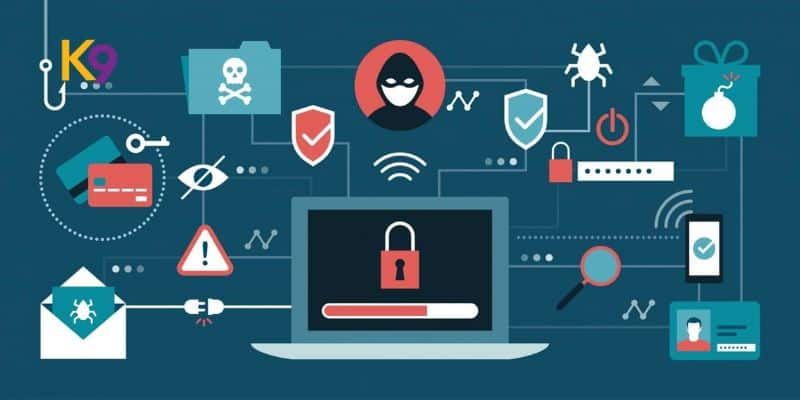In an age dominated by technological innovation, the pervasiveness of digital connectivity has brought unprecedented convenience and efficiency. However, with this increased reliance on digital platforms comes an escalating risk of cyber threats. Safeguarding sensitive information and digital assets has become a paramount concern for individuals and organizations.
The complex landscape of cyberattacks, ranging from phishing schemes to sophisticated malware, necessitates a proactive and comprehensive approach to cybersecurity. This guide gives readers insights and practical strategies to fortify their digital defenses. By understanding the evolving threat landscape and implementing robust cybersecurity measures, individuals and businesses can navigate the digital realm more resiliently and confidently.
Understanding the Threat Landscape
Understanding cyber threats' intricate and dynamic landscape is foundational to constructing a resilient cybersecurity strategy. Cyber adversaries employ an arsenal of tactics, from deceptive phishing emails and insidious malware to coercive ransomware attacks and manipulative social engineering techniques. Recognizing the diversity of these threats is critical for developing effective defense mechanisms.
Phishing, for instance, involves fraudulent attempts to acquire sensitive information by posing as trustworthy entities. Malware, a broad category encompassing viruses and malicious software, can exploit system vulnerabilities to compromise data integrity. Ransomware, a particularly insidious threat, encrypts critical files, demanding payment for their release. Social engineering, on the other hand, relies on psychological manipulation to deceive individuals into divulging confidential information.
The rapid evolution of attack techniques further complicates the threat landscape. As cyber criminals adapt to countermeasures, new vulnerabilities emerge. Individuals and organizations must stay abreast of these developments, recognizing that an effective cybersecurity strategy requires continuous education and adaptation. By comprehending the multifaceted nature of cyber threats, stakeholders can tailor their defenses to mitigate risks effectively, creating a robust barrier against an ever-evolving array of digital dangers.
Tips for Strengthening Your Digital Defenses
1. Implement Robust Password Policies
Implementing robust password policies is a fundamental component of any comprehensive cybersecurity strategy. The strength of your passwords directly correlates with the resilience of your digital defenses. Encourage users to create complex passwords by combining upper- and lower-case letters, numbers, and special characters. Regularly updating passwords is crucial to thwarting potential breaches and preventing unauthorized access to sensitive information.
Multi-factor authentication (MFA) adds an extra layer of security by requiring users to verify their identity through multiple means. This additional step significantly reduces the risk of unauthorized access, even if passwords are compromised. Educate users on the importance of avoiding easily guessable information in their passwords, such as birthdays or common words.
2. Keep Software and Systems Updated
Maintaining the security of your digital ecosystem hinges on the timely updating of software and systems. Cyber threats often exploit outdated applications, operating systems, and security software vulnerabilities. Regular updates, which include security patches and enhancements, serve as a crucial deterrent against potential breaches.
Automated updates are an invaluable tool, ensuring that your digital infrastructure stays fortified without burdening users. By enabling computerized updates for operating systems, antivirus programs, and various applications, you create a proactive defense mechanism that guards against evolving cyber threats.
The significance of keeping software and systems updated cannot be overstated, as this practice serves as a proactive measure against emerging vulnerabilities. In the dynamic landscape of cybersecurity, where new threats constantly surface, maintaining an up-to-date digital environment is a pivotal strategy for building a robust defense against potential exploits and ensuring the overall integrity of your digital infrastructure.
3. Employ Advanced Endpoint Protection
Safeguarding against cyber threats extends to the devices we use daily, making the employment of advanced endpoint protection paramount. Traditional antivirus software may need to catch up with sophisticated attacks, making advanced solutions crucial for comprehensive defense.
Endpoint protection goes beyond conventional antivirus measures, offering real-time threat detection and response capabilities. By utilizing advanced technologies like behavioral analysis and machine learning, these solutions identify and neutralize emerging threats, fortifying your devices against malware, ransomware, and other malicious activities.
Prioritizing advanced endpoint protection is a proactive step in securing the interconnected devices within your digital ecosystem, ensuring a resilient defense against the evolving landscape of cyber threats.
4. Regularly Back Up Data
Data loss can have severe consequences, whether due to a cyberattack, hardware failure, or accidental deletion. Implementing a robust backup strategy ensures that critical information is securely stored and can be recovered in case of a data breach or system failure.
Regularly back up data to an external and secure location, separate from your primary system. Cloud-based solutions and external hard drives are famous for creating redundant copies of essential data. This practice safeguards against potential ransomware attacks and provides a safety net for unforeseen circumstances, allowing for the restoration of business operations with minimal downtime.
5. Monitor Network Traffic
The constant flow of data within networks creates an opportunity for vigilant observation, enabling the timely detection of unusual patterns or suspicious activities.
Intrusion detection and prevention systems play a pivotal role in monitoring network traffic. These sophisticated tools analyze incoming and outgoing data, identifying deviations from established patterns that may indicate a security threat. By actively monitoring network activities, organizations can swiftly respond to potential incidents, minimizing the impact of cyberattacks.
Network monitoring tools provide insights into normal network behavior, making it easier to discern anomalies indicative of a security breach. Proactive monitoring enhances the organization's ability to detect and respond to threats promptly, reducing the risk of data compromise and system vulnerabilities.
6. Collaborate with Cybersecurity Professionals
Collaboration with cybersecurity professionals and regular security assessments are indispensable components of a holistic cybersecurity strategy. As the threat landscape evolves, engaging with experts in the field becomes essential to stay ahead of emerging risks and vulnerabilities.
Cybersecurity professionals bring specialized knowledge and skills, conducting thorough security assessments to identify potential weaknesses in systems and processes. Regular audits and assessments help ensure that cybersecurity measures align with industry best practices and compliance standards. This proactive approach allows organizations to continuously adapt and fortify their defenses against the ever-changing tactics employed by cyber adversaries.
Conclusion
In a digital landscape fraught with cyber threats, the proactive strengthening of your digital defenses is necessary and a responsibility. Adopting a comprehensive cybersecurity approach that includes employee education, advanced technology solutions, and regular assessments can significantly reduce the risk of falling victim to cyberattacks. As the threat landscape evolves, staying vigilant and continually adapting your cybersecurity strategy will be vital to maintaining a robust defense against ever-changing digital threats.





You must be logged in to post a comment.